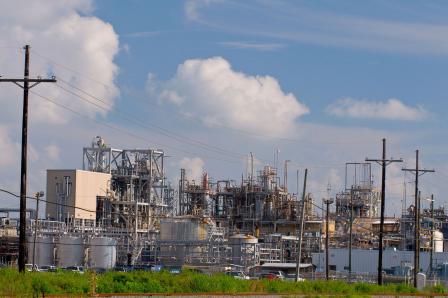Petroleum Refining Effluent Guidelines
 EPA promulgated the Petroleum Refining Effluent Guidelines and Standards (40 CFR Part 419) in 1974 and amended the regulations in 1975, 1977, 1982 and 1985. The regulations cover wastewater discharges at over 140 refineries across the country. The effluent guidelines and standards are incorporated into NPDES permits for direct dischargers
EPA promulgated the Petroleum Refining Effluent Guidelines and Standards (40 CFR Part 419) in 1974 and amended the regulations in 1975, 1977, 1982 and 1985. The regulations cover wastewater discharges at over 140 refineries across the country. The effluent guidelines and standards are incorporated into NPDES permits for direct dischargersOn this page:
- What is Petroleum Refining?
- Facilities Covered
- Industry Studies
- Implementation and Guidance Documents
- Rulemaking History
- Additional Information
What is Petroleum Refining?
Petroleum refineries process raw crude oil into three categories of products:
- Fuel products – gasoline, distillate fuel oil, jet fuels, residual fuel oil, liquefied petroleum gases, refinery fuel, coke & kerosene
- Nonfuel products – asphalt and road oil, lubricants, naphtha solvents, waxes, nonfuel coke, & miscellaneous products
- Petrochemicals and petrochemical feedstocks – naphtha, ethane, propate, butane, ethylene, propylene, butlyene, & BTEX compounds (benzene, toluene, ethylbenzene, & xylene)
| Process category | Processes | Description |
|---|---|---|
| Topping (Separating crude oil) |
|
Separates crude oil into hydrocarbon groups |
| Thermal & catalytic cracking |
|
Breaks large, heavy hydrocarbons from topping process into smaller hydrocarbons |
| Combining/rearranging hydrocarbons |
|
Processes hydrocarbons to form desired end products |
| Removing impurities | Catalytic hydrotreating | Removes impurities such as sulfur, nitrogen & metals from products or waste gas streams |
| Specialty products blending & manufacturing |
|
Blends product streams into final products or final processing into specialty products |
| Wastewater | Description |
|---|---|
| Desalter water | Water produced from washing the raw crude prior to topping operations. |
| Sour water | Wastewater from steam stripping & fractionating operations that comes into contact with the crude being processed. |
| Other process water | Wastewater from product washing, catalyst regeneration & dehydrogenation reactions. |
| Spent caustic | Formed in extraction of acidic compounds from product streams. |
| Tank bottoms | Bottom sediment and water settles to the bottom of tanks used to store raw crude. The bottoms are periodically removed. |
| Cooling tower | Once-through cooling tower water & cooling tower blowdown to prevent buildup of dissolved solids in closed-loop cooling systems. |
| Condensate blowdown | Blowdown from boilers and steam generators to control buildup of dissolved solids. |
| Source water treatment system | Source water must be treated prior to use in the refinery. Waste streams may include water from sludge dewatering if lime softening is used; ion exchange regeneration water; or reverse osmosis wastewater. |
| Stormwater | Process area and non-process area runoff from storm events. |
| Ballast water | Ballast water from product tankers. |
Petroleum refineries are categorized under NAICS code 32411. (Note: the NAICS group listing is provided as a guide and does not define the coverage of the Petroleum Refining regulations. For precise definitions of coverage, see the applicability sections in 40 CFR Part 419.)
Facilities Covered
Covered wastestreams include process wastewater; ballast water; once-through cooling water; contaminated & uncontaminated stormwater.
| Subcategory | Basic Refinery Operations Included |
|---|---|
| A. Topping | Topping, catalytic reforming, asphalt production, or lube oil manufacturing processes, but excluding any facility with cracking or thermal operations |
| B. Cracking | Topping and cracking |
| C. Petro-chemical | Topping, cracking & petrochemical operations* |
| D. Lube | Topping, cracking & lube oil manufacturing processes |
| E. Integrated | Topping, cracking, lube oil manufacturing processes & petrochemical operations* |
Industry Studies
2015-16 Detailed Study
EPA is conducting a detailed study of the Petroleum Refining category to consider revisions to the regulations.
EPA specifically solicits data and information on the discharge of metals and dioxin from petroleum refineries, including for example, the source(s) of these contaminants, either in crude oil sources or in the refining process, the effects of new air pollution controls on wastewater discharges at refineries, and information on current and future trends in oil refining processes. The Agency also solicits data and information on current wastewater treatment technology performance at petroleum refineries, as well as any other information believed to be relevant to its study of this issue.
Previous Studies
- 2004 Study (Section 7 of the Technical Support Document for the 2004 Effluent Guidelines Program Plan; EPA 821-R-04-014, August 2004)
- 1996 Study (EPA 821-R-97-003, April 1996)
Implementation and Guidance Documents
- Industrial Stormwater Fact Sheet:
Sector C - Chemical and Allied Products Manufacturing and Refining Facilities (EPA 833-F-06-018, December 2006) - Guide for the Application of Effluent Limitations Guidelines for the Petroleum Refining Category (June 1985)
Rulemaking History
1985 Amendment
- Documents, including:
- Final rule (correction): 50 FR 32414, 8/12/1985
- Final rule: 50 FR 28516, 7/12/1985
- Proposed rule: 49 FR 34152, 8/28/1984
1982 Amendment
- Documents, including:
- Final rule: 47 FR 46434, 10/18/1982
- Development Document
- Proposed rule: 44 FR 75926, 12/21/1979
1977 Amendment
- Documents, including:
- Interim final rule: 42 FR 15684, 3/23/1977
- Development Document Supplement for Pretreatment
- Proposed rule: 39 FR 16574, 5/9/1974
1975 Amendment
- Documents, including:
- Final rule: 40 FR 21939, 5/20/1975
- Proposed rule: 39 FR 37069, 10/17/1974
1974 Initial Rulemaking
- Documents, including:
- Final rule: 39 FR 16560, 5/9/1974
- Development Document
- Proposed rule: 38 FR 34542, 12/14/1973
Additional Information
For additional information regarding the existing Petroleum Refining Effluent Guidelines regulations, please contact Ahmar Siddiqui (siddiqui.ahmar@epa.gov) or 202-566-1044.
For additional information regarding the 2015-16 Detailed Study, please contact Phillip Flanders (flanders.phillip@epa.gov) or 202-566-8323.
